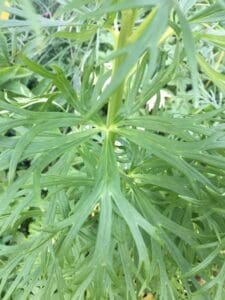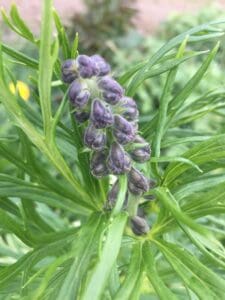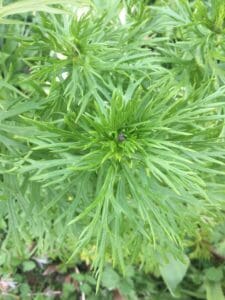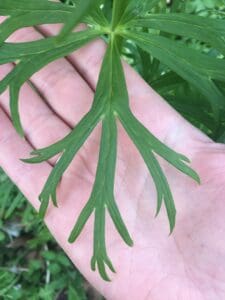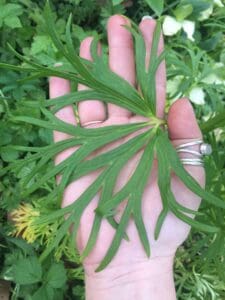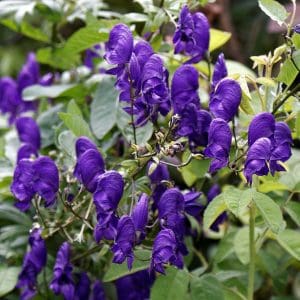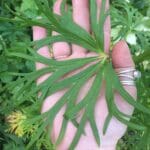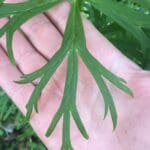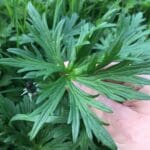Monkshood / Spring / Summer / Autumn / Toxic
Monkshood is an absolute delight to see through Spring and it’s worth learning from a foraging perspective, not to enjoy in dinner but to be completely careful not to pick it for food when out foraging for other plants and species. It’s is known for being deadly toxic!
Common Names
Dogs Bane, Wolfsbane, Venus’ chariot, Old Wives Hood
Botanical Name
Aconitum napellas
Scientific Classification
Kingdom – Plantae
Order – Ranunculales
Family – Ranunculaceae
Physical Characteristics of Monkshood
A tall, hairless herbaceous perennial plant growing up to 1m tall and producing a beautiful purple flower spike.
Leaves
Leaves grow 5-10cm in diameter and are palmately divided into 5-7 deeply lobed segments with further lobes protruding from these.
Flowers
Blue to dark purple flowers compromising of 2-5 petals with one petal becoming a broad hood shape. The flowers form a spike cluster.
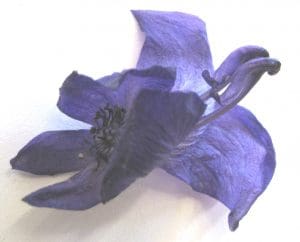
Habitat
Commonly grown in gardens, this plant is also found growing in the wild and is native to Western and Central Europe. It prefers shaded banks by streams.
Known Hazards
All parts of this plant are considered deadly poisonous and you need to take care even with handling it. The whole plant contains a toxin called aconitine which is a nerve and heart poison and can be fatal. Poisonings commonly happen in Asia due to it being used medicinally. Poisoning can also occur if handling the plant as aconitine is easily absorbed through the skin. It is rare but this can also be deadly.
Could be Confused with
Luckily there are very few look-a-likes to Monkshood. The young plants of Mugwort might look similar with their deeply lobed leaves – but they have bright silver undersides to the leaf, and the flowers look completely different.
Edible Uses
Do not consume this plant!
Notes on Herbal uses
Do not consume this plant!
Extra notes from the Foragers
Monkshood (Aconitum), also known as wolf’s bane or blue rocket, is one of the most toxic plants in the world, thanks to its high concentration of alkaloids, especially aconitine. The name “aconitine” may not ring any immediate alarm bells, but it should. This potent neurotoxin is the primary reason that Monkshood has a lethal reputation, with effects so powerful that even minimal exposure can cause severe health problems or death.
Aconitine belongs to a group of diterpenoid alkaloids, which are plant-derived compounds that affect the human nervous system and cardiovascular system. The poison specifically targets voltage-gated sodium channels in the body’s nerve and muscle cells, which play a crucial role in generating and transmitting electrical signals. Let’s explore how aconitine interacts with these sodium channels to produce its toxic effects.
How Aconitine found in Monkshood Works
Sodium channels act as tiny “gates” in the membranes of our cells. Normally, these channels open and close to allow the passage of sodium ions, which helps create the electrical signals that regulate things like muscle contractions and nerve impulses. Aconitine binds to these channels and prevents them from closing, causing a prolonged influx of sodium ions. This constant flow of sodium keeps the nerve or muscle cell in a state of depolarization, meaning it’s unable to return to its resting state.
This sustained depolarization throws the entire nervous system into chaos. It overstimulates the nerves, leading to early symptoms like tingling, numbness, and burning sensations on the skin, even with just skin contact. When ingested, more severe effects like vomiting, abdominal pain, diarrhea, and sweating soon follow. The disruption to nerve signals also extends to the heart and muscles, leading to life-threatening conditions like arrhythmias (irregular heartbeats), hypotension (low blood pressure), and paralysis.
Effects on the Cardiovascular System
The heart is particularly vulnerable to aconitine’s effects because of its reliance on precise electrical signals to function properly. Aconitine disrupts these signals, leading to irregular heart rhythms (ventricular arrhythmias) that can cause the heart to either beat too quickly or too erratically to pump blood effectively. This can result in fatal complications like ventricular fibrillation, where the heart quivers instead of pumping, leading to sudden cardiac arrest.
As the poison continues to wreak havoc on the heart, the victim often experiences a progressive slowdown of their pulse, followed by heart failure if treatment is not administered promptly. The respiratory system also becomes compromised, leading to shortness of breath or respiratory arrest. The combination of these symptoms makes aconitine poisoning particularly difficult to treat.
Symptoms and Onset
What makes aconitine particularly insidious is how quickly its effects manifest. Symptoms can appear within minutes of ingestion or skin contact, and the progression is rapid. Early signs of aconitine poisoning include a burning or tingling sensation around the mouth and lips, salivation, sweating, nausea, and vomiting. As the poison spreads through the bloodstream, victims may experience dizziness, difficulty breathing, muscle weakness, and confusion.
The severity of the symptoms depends on the dose of aconitine. Even minute amounts of aconitine can be deadly, making the lethal dose around 1-2 milligrams of pure aconitine for an adult. This means that ingesting just a small portion of the plant can result in a fatal outcome. Without rapid medical intervention, death usually occurs due to respiratory failure, ventricular arrhythmia, or cardiac arrest.
Modern Treatment and Challenges
There is no specific antidote for aconitine poisoning, which makes it especially dangerous. Treatment is usually supportive and focused on managing the symptoms as they arise. Doctors may administer activated charcoal to help absorb any remaining toxins in the digestive tract if the poisoning is caught early enough. Intravenous fluids, medications to control heart rhythm (such as lidocaine or amiodarone), and mechanical ventilation are often required to support the heart and lungs while the body tries to metabolize and expel the toxin.
Despite these interventions, the prognosis for aconitine poisoning is poor if medical treatment is delayed. The rapid onset of symptoms and the difficulty in reversing the poison’s effects make Monkshood a plant to approach with extreme caution.
In summary, the deadly aconitine found in Monkshood disrupts normal cellular function by keeping sodium channels perpetually open, leading to a cascade of devastating effects on the nervous system, heart, and muscles. The poison’s rapid onset and lack of a reliable antidote make it one of the most feared plant toxins known to humankind. Despite the plant’s beauty and historical allure, it’s best admired from a distance—far away from any potential contact with its lethal chemistry.
Learn more about the toxins found in Monkshood here
In ancient times it’s known that arrows were dipped in the sap from Monkshood to be used as a poison for hunting and in battle. Reports show that this poison has been used for thousands of years. At the end of the Roman rule in Europe it was illegal to grow and if caught you would have been sentenced to death.



